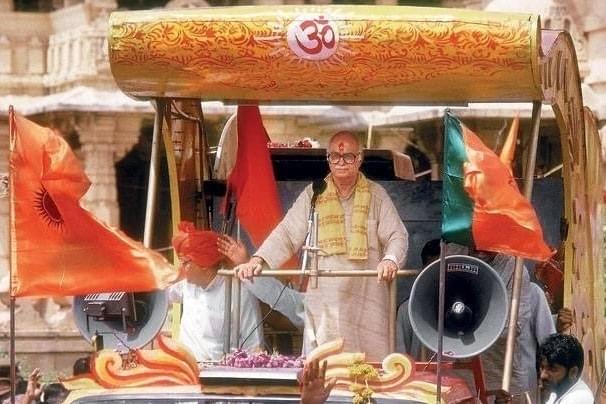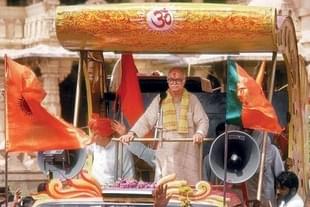Politics
Ayodhya: Everything That Happened Before 30 October 1990
Aravindan Neelakandan
Nov 26, 2023, 07:00 PM | Updated Dec 26, 2023, 05:58 PM IST
Save & read from anywhere!
Bookmark stories for easy access on any device or the Swarajya app.


Lal Krishna Advani had come to India as a Hindu refugee after Partition from what is today Pakistan. Born in 1927, he was around 63 when he launched the Rath Yatra.
The rath itself was a redesigned Toyota vehicle. In the 1990s, India’s roads were narrow and travel by road was torturous. The Yatra was planned over a distance of around 10,000 kilometres. It was perhaps the largest mass outreach programme ever undertaken after the freedom struggle. In sheer numerical terms though, it surpassed any of the Gandhian movements, reaching out to a larger number of people and villages.
Simultaneously, Vishwa Hindu Parishad (VHP) had also launched Shri Ram Jyoti Yatra.
That year Vijayadasami was on September 28. The VHP took out various rallies and reached out to people in almost every nook and corner of India. Then Deepavali followed on October 18 and the VHP gave a call to light a lamp for Shri Ram Lalla of Ayodhya – in every home a Ram Jyoti.
Devotthan Ekadasi of 1990 would fall on 30 October. Sants and sadhus resolved to commence the construction of the temple at the location where the sacred idols of Ram Lalla were placed, on that day. Advani had already announced that his Rath Yatra would culminate at Ayodhya on 30 October. An unprecedented, euphoric Rama wave could be felt building up throughout India.
There was little doubt about who would enjoy the advantages of such a wave as it transformed into a massive force sweeping across the nation. However, Advani himself remained unaffected by this extensive public response. In an interview, he clarified that according to him, the public sentiment was a manifestation of devotion to Lord Rama and not necessarily support for a politically party.
However, on the other side of the political spectrum, ideologically diverse parties found themselves bundled in one space – the anti-temple zone.
On 17 October, 1990, an all-party meeting was conveyed by Prime Minister V.P.Singh. The BJP boycotted it. The Congress which was on the same side as Janata Dal with respect to the Ayodhya issue, also boycotted it.
The BJP's boycott was ideological, and Congress boycotted due to Rajiv Gandhi's animosity towards V.P. Singh.
In the same period, during a crucial BJP meeting in Delhi, Advani discussed potential actions if the Rath Yatra was halted. On October 18, he boarded the Rajdhani Express from Delhi to continue the Rath Yatra in Bihar, which was then under Lalu Prasad Yadav's rule.
The question arose for Lalu and V.P. Singh: should Advani be stopped now?
Lalu aimed to halt the Rajdhani Express and arrest Advani, but V.P. Singh, concerned about BJP's support, dissuaded Lalu from this action. Intelligence Bureau officials approached Atal Bihari Vajpayee, considered a soft target, to persuade Advani to stop the Rath Yatra. In their presence, Vajpayee phoned Advani via landline, announcing after a brief discussion that Advani would not halt the Yatra.
Meanwhile a Presidential ordinance was issued to take over the disputed land in Ayodhya. That was on the very next day of Deepavali, 19 October. This had a single objective: to obstruct the VHP from conducting Kar Seva in Ayodhya. However, this decision was reversed within two days.
On 22 October, during a Chief Ministers’ conference in Delhi, battle lines were drawn. The Communist Party of India (Marxist) ruled Kerala and West Bengal, with both Chief Ministers advocating for Advani's arrest. Mulayam Singh Yadav, the Chief Minister of Uttar Pradesh at the time and in conflict with Devi Lal, shared their sentiments. V.P. Singh had previously attempted to appoint Ajit Singh instead of Mulayam as the CM of Uttar Pradesh, leading Mulayam to seek revenge. If Mulayam’s action would in any way lead to the BJP withdrawing support from VP Singh’s government in the Centre, that would be victory for the UP CM.
He declared his intention to not only halt the Rath Yatra but also prevent anyone from approaching Shri Rama Janmabhoomi in Ayodhya.
As the inevitable fall of the V.P. Singh Government loomed, a race ensued to demonstrate who was the foremost defender of Islamist interests in India. The internal political divisions within the Janata Dal made it evident that not only would the V.P. Singh Government collapse, but the Janata Dal party would also split. V.P. Singh, determined not to let Mulayam Singh take credit for Advani's arrest, had made a decision.
Meanwhile, the yatra had moved on from Dhanbad and Gaya and reached Patna on 22 October. Advani addressed a mammoth crowd at Gandhi Maidan. As he was addressing the public meeting, there was a public address broadcast by the then Prime Minister, V.P.Singh. He said that the nation was in a communally dangerous situation. Every brother of one religion should protect the other, he said. The speech was dark and ominous. It was clear what the intention was. There was also an indirect appeal to the Congress MPs to support him if the BJP were to withdraw support. It was evident that Lalu Prasad and, consequently, V.P. Singh would claim credit for halting the Rath Yatra. However, there was no indication of Advani's arrest.
On October 23, 1990, Advani was awakened early in the morning by the Bihar police at the Patna Government Guest House. He was presented with an arrest warrant by the district magistrate. Advani requested a few minutes, during which he wrote a letter to the President of India, declaring that the BJP was withdrawing its support from the V.P. Singh Government.
Mulayam Singh Yadav, the Chief Minister of Uttar Pradesh, just realized that his thunder had been stolen. Determined to upstage Lalu-V.P. Singh, he decided on a course of action.
Meanwhile, there were movements across the country, slow, silent, and exhilarating, converging towards Ayodhya. Mulayam Singh’s plan was to prevent anyone from even approaching the town.
He commanded the entire police department, including the state Intelligence Bureau and the entire state machinery, to work with a single objective – halt all human movements towards Ayodhya. Declaring that not even a crow would be allowed to fly over Shri Rama Janmabhoomi, he ensured that the might of Uttar Pradesh administration would make the planned Kar Seva on October 30 a monumental failure for Hindu organizations. Every road was blocked, and every government school was turned into a makeshift prison as the taluk prisons on the route to Ayodhya began overflowing with arrested pilgrims.
The UP government decided that not only the pilgrims but the people who were leading the cadre would be arrested too. Mahant Avaidyanath of Gorakhpur Math was arrested. Swami Chinmayananda (not to be confused with the popular Vedanta preacher-monk and founder of Chinmaya Mission) was arrested. So Dr. Rajendra Singh of the RSS.
But the kar sevaks were in no mood to give up. In the dead of night, traversing wheat fields and obscure village roads, people from across India, spanning all ages from youths to septuagenarians, walked. Unarmed and lacking protection, they relied solely on the name of Ram. They entered the villages of Uttar Pradesh, where they were unfamiliar with the local language. Yet, the power of one name was sufficient. Villagers, risking police arrest, provided shelter and food to these pilgrims bound for Ayodhya.
Muthuswamy, over seventy, traveled from Kanyakumari district, the southernmost part of India, with a determination to perform Kar Seva at Ayodhya. Upon reaching the UP border, where walking became a physical challenge due to old age, he persisted. Villagers, moved by his resolve, carried him on their shoulders, demonstrating the unifying power of the name of Rama that transcended language, caste, and politics.
October 30 approached.
This is the fifth piece in the 'Ayodhya 2024' series that Aravindan Neelakandan is writing in the build-up to the inauguration of the Shri Rama Janmabhoomi temple. We will be publishing one article every week. You can read the rest of the pieces in the series here.





